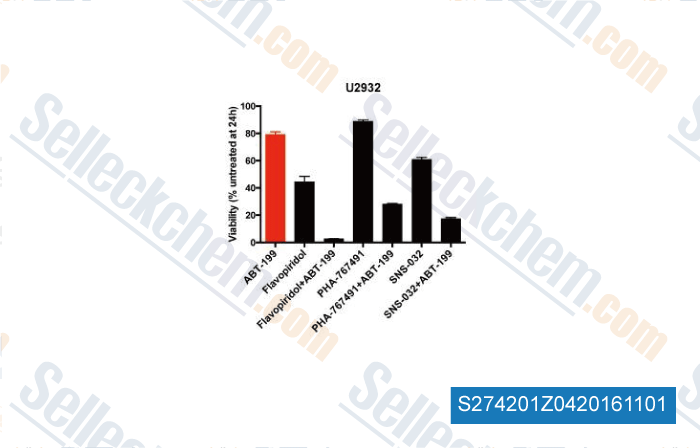|
Toll Free: (877) 796-6397 -- USA and Canada only -- |
Fax: +1-832-582-8590 Orders: +1-832-582-8158 |
Tech Support: +1-832-582-8158 Ext:3 Please provide your Order Number in the email. |
Technical Data
| Formula | C12H11N3O.HCl |
|||
| Molecular Weight | 249.7 | CAS No. | 942425-68-5 | |
| Solubility (25°C)* | In vitro | DMSO | 24 mg/mL (96.11 mM) | |
| Water | Insoluble | |||
| Ethanol | Insoluble | |||
|
* <1 mg/ml means slightly soluble or insoluble. * Please note that Selleck tests the solubility of all compounds in-house, and the actual solubility may differ slightly from published values. This is normal and is due to slight batch-to-batch variations. * Room temperature shipping (Stability testing shows this product can be shipped without any cooling measures.) |
||||
Preparing Stock Solutions
Biological Activity
| Description | PHA-767491 (CAY10572, NMS 1116354) HCl is a potent ATP-competitive dual Cdc7/CDK9 inhibitor with IC50 of 10 nM and 34 nM in cell-free assays, respectively.It displays ~20-fold selectivity against CDK1/2 and GSK3-β, 50-fold selectivity against MK2 and CDK5, 100-fold selectivity against PLK1 and CHK2. | |||||||||||
|---|---|---|---|---|---|---|---|---|---|---|---|---|
| Targets |
|
|||||||||||
| In vitro | PHA-767491 displays approximately 20-fold selectivity for Cdk1, Cdk2 and GSK3-β, 50-fold selectivity for MK2 and Cdk5 and 100-fold selectivity for PLK1 and CHK2. PHA-767491 inhibits cell proliferation in a variety of human cell lines with IC50 of 0.86 μM for SF-268 to 5.87 μM for K562, and significantly induces apoptosis in a p53-independent manner in almost all cell lines in contrast with 5-FU which only works in a few of cell lines. Unlike current DNA synthesis inhibitors, PHA-767491 treatment at 5 μM blocks the initiation of DNA replication but not replication fork progression, due to specific inhibition of Cdc7 kinase and Mcm2 phosphorylation at the Cdc7-dependent Ser40 site. [1] The up-regulated Mcl-1 levels in ABT-737-resistant OCI-LY1 and SU-DHL-4 cells can be significantly decreased by PHA-767491 treatment at 3 μM possibly due to the inhibition of Cdk9, leading to the restoration of the sensitivity to ABT-737. [2] The direct mitochondrial dependent pro-apoptosis effect of PHA-767491 is also observed when applied at 1 μM in quiescent chronic lymphocytic leukemia (CLL) cells through the similar mechanism with EC50 of 0.34-0.97 μM. While in proliferating CLL cells stimulated by CD154 and interleukin-4, PHA-767491 treatment at 5 μM abolishes DNA synthesis by inhibiting Cdc7 rather than triggering cell death. [3] |
|||||||||||
| In vivo | Administration of PHA-767491 twice a day for 5 days significantly inhibits the growth of HL60 xenograft in a dose-dependent manner with TGI of 50% and 92% at dose of 20 mg/kg and 30 mg/kg, respectively, the effect of which is also marked in A2780, Mx-1, and HCT-116 xenograft models as well as the mammary carcinomas, and correlates with Cdc7 inhibition and subsequently decreased phosphorylation of Mcm2 at the Cdc7-dependent site Ser40 [1] |
|||||||||||
| Features | The first inhibitor that directly affects the mechanisms controlling initiation as opposed to elongation in DNA replication. |
Protocol (from reference)
| Kinase Assay: |
|
|---|---|
| Cell Assay: |
|
| Animal Study: |
|
References
|
Customer Product Validation

-
, , Leukemia, 2015, 29(8):1702-12.
Selleck's PHA-767491 HCl has been cited by 46 publications
| p53-dependent crosstalk between DNA replication integrity and redox metabolism mediated through a NRF2-PARP1 axis [ Nucleic Acids Res, 2024, gkae811] | PubMed: 39315696 |
| ATR limits Rad18-mediated PCNA monoubiquitination to preserve replication fork and telomerase-independent telomere stability [ EMBO J, 2024, 43(7):1301-1324] | PubMed: 38467834 |
| Loss of POLE3-POLE4 unleashes replicative gap accumulation upon treatment with PARP inhibitors [ Cell Rep, 2024, 43(5):114205] | PubMed: 38753485 |
| Single-cell analysis reveals host S phase drives large T antigen expression during BK polyomavirus infection [ PLoS Pathog, 2024, 20(12):e1012663] | PubMed: 39636788 |
| Multiplex single-cell chemical genomics reveals the kinase dependence of the response to targeted therapy [ Cell Genom, 2024, 4(2):100487] | PubMed: 38278156 |
| K6-linked ubiquitylation marks formaldehyde-induced RNA-protein crosslinks for resolution [ Mol Cell, 2023, 10.1016/j.molcel.2023.10.011] | PubMed: 37951215 |
| ATR protects ongoing and newly assembled DNA replication forks through distinct mechanisms [ Cell Rep, 2023, 42(7):112792] | PubMed: 37454295 |
| The nucleolar protein GNL3 prevents resection of stalled replication forks [ EMBO Rep, 2023, 24(12):e57585] | PubMed: 37965896 |
| The nucleolar protein GNL3 prevents resection of stalled replication forks [ EMBO Rep, 2023, 24(12):e57585] | PubMed: 37965896 |
| Systematic screening identifies ABCG2 as critical factor underlying synergy of kinase inhibitors with transcriptional CDK inhibitors [ Breast Cancer Res, 2023, 25(1):51] | PubMed: 37147730 |
RETURN POLICY
Selleck Chemical’s Unconditional Return Policy ensures a smooth online shopping experience for our customers. If you are in any way unsatisfied with your purchase, you may return any item(s) within 7 days of receiving it. In the event of product quality issues, either protocol related or product related problems, you may return any item(s) within 365 days from the original purchase date. Please follow the instructions below when returning products.
SHIPPING AND STORAGE
Selleck products are transported at room temperature. If you receive the product at room temperature, please rest assured, the Selleck Quality Inspection Department has conducted experiments to verify that the normal temperature placement of one month will not affect the biological activity of powder products. After collecting, please store the product according to the requirements described in the datasheet. Most Selleck products are stable under the recommended conditions.
NOT FOR HUMAN, VETERINARY DIAGNOSTIC OR THERAPEUTIC USE.
